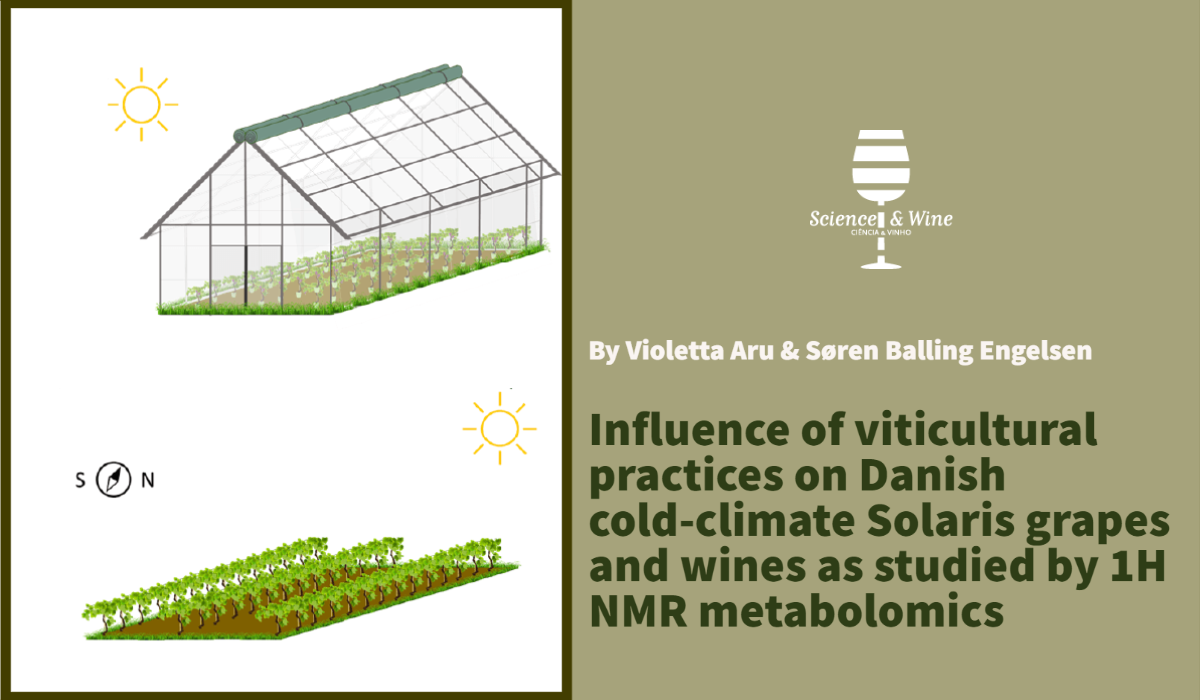By Violetta Aru & Søren Balling Engelsen
Department of Food Science, University of Copenhagen, Rolighedsvej 26, DK-1958 Frederiksberg, Denmark. Email: violetta@food.ku.dk; se@food.ku.dk
Climate change combined with new grape cultivars, well-adapted to shorter and cooler seasons, are main drivers in the development of new cool climate viticultural areas in Northern Europe, with the Scandinavian countries counting over 150 wine producing companies1. Among Scandinavian countries, in 2000, Denmark and Sweden were recognized and registered in the European Union as new regions for commercial wine production and the viticultural area development in Denmark has since shown an exponential growth, reaching 170 ha in 20222.
Historically, viticultural areas have been identified on a scale from cool to warm regions, with the coolest regions (also known as cool-climate viticultural areas), such as Champagne in France and Rheingau in Germany, having average temperatures of about 14.5 °C (first half of the 20th century) in the growing season (April–October). In the same period, the average temperature in Denmark (country average) was approximately 12 °C (±0.3), still cooler than traditional cool climate areas.
Solaris is a white PIWI (German: Pilzwiderstandsfähig) cultivar of Vitis vinifera (L.) that thrives in Denmark. It was created in 1975 at the grape breeding institute in Freiburg (Germany) by Norbert Becker crossing the interspecific grape variety “Merzling” (V. rupestric and V. linsecumii backcrossed with V. vinifera for 6 generations) with a hybrid variety obtained by crossing “Zarya Severa” (V. amurensis as a grandparent) and “Muscat Ottonel” (V. vinifera). Solaris is an early-ripening white grape with good resistance against fungal diseases and to frost3. Due to its sensory profile4 and its adaptation to a short season, it is increasingly grown in northern European countries with marginal climate for winemaking, such as the Alpine region, Belgium, the Netherlands, England, Poland, Sweden and Denmark.
The untargeted analysis of must and wines using nuclear magnetic resonance (NMR) spectroscopy metabolomics has opened new opportunities to evaluate the entire grape-growing and wine-making processes. Proton (1H) NMR spectroscopy is a rapid, quantitative and relatively unbiased analytical platform that has successfully been applied for the overall chemical characterization of must and wines as well as to study the effect of vintage, terroir, viticultural and vinery practices5.
In our study6, 1H NMR spectroscopy was utilized to measure different wines made from Solaris grapes. The samples were collected from vines that underwent different viticultural practices, namely crop thinning, defoliation and a combination of the above. The same analytical approach was used to determine whether short-term water stress carried out at different stages of Solaris berry development (namely, pre-veraison, veraison, and ripening) will impact the quality of the final wines. Metabolites identified from the 1H NMR spectra were quantified and variations in the chemical composition of the must and wines as a function of viticultural practices and water stress were assessed by multivariate data analysis, namely: principal component analysis (PCA)7 and ANOVA-simultaneous component analysis (ASCA)8.
A graphical overview of the experimental design is given in Figure 1.

Figure 1. Experimental design. The water deficit experiment was carried out in a screenhouse with open roof and sides, which are automatically closed in case of rain (A). A total of 36 pot-grown vines underwent water stress at pre-veraison (early- stress, ES), veraison (mid-stress, MS), and ripening (late-stress, LS). Irrigation was carried out by an automated centralized drip irrigation system. The field experiment (B) was performed in a north–south oriented vineyard where 32 vines underwent different viticultural treatments, namely crop thinning (CT), defoliation (DEF), and a combination of the above (DCT). Must and wine samples from all treatments were measured by 1H NMR. Multivariate data analysis was employed to assess the impact of water deficit and different viticultural practices on the chemical composition of must and wine samples. MJ: must; W: wine; DOE: design of experiment.
The results of our investigation showed that viticultural practices (defoliation and crop thinning) are able to affect the amino acid and sugar content of Solaris must, and thereby the quality of the final wine. When compared to control wines, defoliation decreased the content of amino acids and sugars, while compounds normally related to fruity aroma (i.e., isopentanol), non-sugar sweetness (i.e., proline and glycerol), and alcohol content were found to be highest in wines made from crop-thinned plants. The content of tyrosol, a natural phenolic antioxidant with a high bioavailability, was increased in the final wine by a combination of defoliation and crop thinning. As for the water deficit experiment, the results showed that short-term water deficit at early stages of berry development can affect the concentration of several flavor-related compounds, including glutamate and butyrate, which were increased in the must (glutamate) and final wine (butyrate) when compared to the controls.
The variations in the wine chemistry were further analyzed as a function of the experimental design and this analysis showed that the effect of water deficit accounted for 11% (p< 0.001) and 8% (p< 0.001) of the variability in the metabolite concentrations in must and wines, respectively, while the viticultural practices accounted for 38% (p< 0.001) and 30% (p< 0.001) of the variability in the metabolite concentrations in must and wines, respectively.
Our results show that different viticulture practices have a significant impact on the chemical composition of the final wines. Oppositely, short-term water stress at the latest stage of berry development does not affect the quality of Solaris wines.
Additional information
Aru, V., Nittnaus, A.P., Sørensen, K.M., Engelsen, S.B., Toldam-Andersen, T.B. Effects of Water Stress, Defoliation and Crop Thinning on Vitis vinifera L. cv. Solaris: Part I: Plant Responses, Fruit Development and Fruit Quality. Metabolites 2022, 12, 363.
Aru, V., Nittnaus, A.P., Sørensen, K.M.; Toldam-Andersen, T.B., Engelsen, S.B. Effects of Water Stress, Defoliation and Crop Thinning on Vitis vinifera L. cv. Solaris Must and Wine Part II: 1H NMR Metabolomics. Metabolites 2022, 12, 672.

Violetta Aru is a tenure track assistant professor in high throughput 1H NMR foodomics at Copenhagen University (Department of Food Science), Denmark. Her research focus is on the use of NMR-metabolomics as a tool to promote the green transition in the agriculture and food sector, including complex food production systems, such as aquaculture.

Søren Balling Engelsen is a professor in plant food science at Copenhagen University (Department of Food Science), Denmark. His primary research interests concern spectroscopy (NIR, IR, Raman & NMR) of biological materials, multivariate data analysis of spectroscopic data and molecular modeling of carbohydrates.
References
- Schernewski G. Adaptation to Climate Change: Viniculture and Tourism at the Baltic Coast. In: Schernewski G, Hofstede J, Neumann T, eds. Global Change and Baltic Coastal Zones. Springer Netherlands; 2011:233-247. doi:10.1007/978-94-007-0400-8_14
- Toldam-Andersen TB, Becker JR. The wine industry in Denmark. VitiNord Conference. Published online 2015:1000.
- Boso S, Kassemeyer HH. Different susceptibility of European grapevine cultivars for downy mildew. Vitis – Journal of Grapevine Research. 2008;47(1):39-49.
- Liu J, Toldam-Andersen TB, Petersen MA, Zhang S, Arneborg N, Bredie WLP. Instrumental and sensory characterisation of Solaris white wines in Denmark. Food Chem. 2015;166:133-142. doi:10.1016/j.foodchem.2014.05.148
- Alañón ME, Pérez-Coello MS, Marina ML. Wine science in the metabolomics era. TrAC – Trends in Analytical Chemistry. 2015;74:1-20. doi:10.1016/j.trac.2015.05.006
- Aru V, Nittnaus AP, Sørensen KM, Toldam-Andersen TB, Engelsen SB. Effects of Water Stress, Defoliation and Crop Thinning on Vitis vinifera L. cv. Solaris Must and Wine Part II: 1H NMR Metabolomics. Metabolites. 2022;12(7):672. doi:10.3390/metabo12070672
- Wold S, Esbensen K, Geladi P. Principal component analysis. Chemometrics and Intelligent Laboratory Systems. 1987;2:37-52. doi:10.1016/0169-7439(87)80084-9
- Smilde AK, Jansen JJ, Hoefsloot HCJ, Lamers RJAN, van der Greef J, Timmerman ME. ANOVA-simultaneous component analysis (ASCA): A new tool for analyzing designed metabolomics data. Bioinformatics. 2005;21(13):3043-3048. doi:10.1093/bioinformatics/bti476

